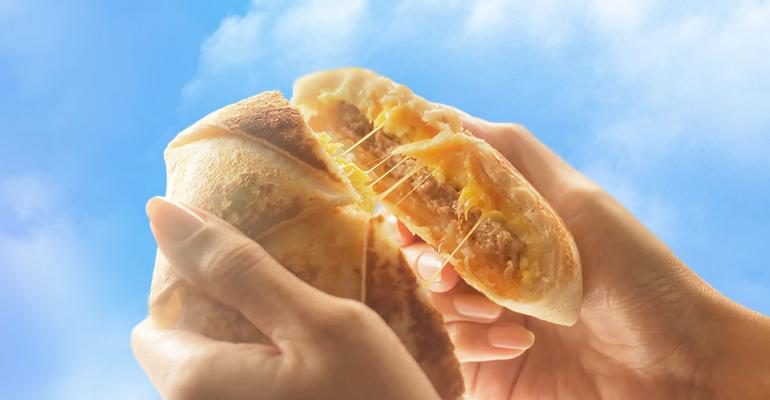Taco Bell’s breakfast business seems to be making a comeback thanks to Pete Davidson. The comedian and former Saturday Night Live star appeared in an ad campaign for the brand during Q4, jokingly apologizing for its “maybe-too-extreme innovations in the mornings.” During parent company Yum Brands’ Q4 earnings call Wednesday morning, CEO David Gibbs said breakfast transactions were up by 9% on the quarter and credited the campaign for driving much of that.
“Taco Bell brought in Pete Davidson to help drive consumer buzz for breakfast. This led to 9% transaction growth for the daypart,” Gibbs said.
This trend is likely welcome news, as breakfast has historically been the most profitable daypart of the restaurant business because of lower food costs and high-profit coffee sales. But the business has struggled throughout the past several years as Covid kept morning commuters off the road. Taco Bell itself actually paused breakfast at many locations during much of 2020.
Notably, breakfast wasn’t the only bright spot for Taco Bell on the quarter. The chain sold 45 million Mexican Pizzas after the product’s return to menus in September, which Gibbs said was particularly impressive given its limited-time availability. On the quarter, same-store sales at Taco Bell U.S. were up by 11%, while the chain opened 250 gross new units this year domestically – the second highest annual amount ever, according to executives. That momentum is expected to continue this year, with record site registrations at the end of 2022.
Pizza Hut U.S. also turned in a strong quarter, with same-store sales up by 4%. Driving much of the chain’s momentum is its continued integration of third-party delivery aggregates. Sales from these aggregates jumped by 30% in Q4.
“We have seen a significant lift in transactions with aggregators. We started the year (2022) with five transactions per store (from aggregator deliveries) and now we’re up to 50 by the end of the year,” Gibbs said. “That is massive progress and helping us access some consumers who weren’t using our brand.”
The chain’s new Melts platform has also provided momentum and is helping the brand connect with younger consumers. Melts were introduced in October and Gibbs said they have overindexed on pre-dinner and individual occasions and have also attracted lower-income consumers due to their strong value proposition. These efforts have helped Pizza Hut gain share in the pizza category, Gibbs added.
Rounding out the company’s domestic portfolio, KFC U.S. same-store sales increased by 1% on the quarter, while The Habit Burger Grill’s same-store sales declined by 1%. Overall, Yum’s executives are confident in the company’s position against a persistently uncertain macroeconomic backdrop.
“The consumer environment remains positive for us. We’re seeing an increase in higher income consumers coming in more frequently – some of that no doubt a trade down – and we’re not seeing the low-end consumer dropping out of our business, but rather more focused on value,” Gibbs said. "I think the environment sets up well for us from a consumer standpoint.”
Gibbs added that labor has also picked up, helping stores return to pre-Covid operating hours.
“We’re able to staff our stores now appropriately,” he said. “Mix it all together and we like the environment we’re in.”
Global unit growth record
A strong proof point for the company in this environment is its ability to keep growing across its diverse footprint. Yum Brands opened over 4,500 gross new units, or nearly 3,100 net new units globally – beating its previous development record set just last year. According to CFO Chris Turner, that equates to about one new restaurant opening every two hours. Nearly 90% of those new store openings in 2022 occurred outside of the U.S. The company ended 2022 with over 55,000 restaurants.
Contact Alicia Kelso at [email protected]





